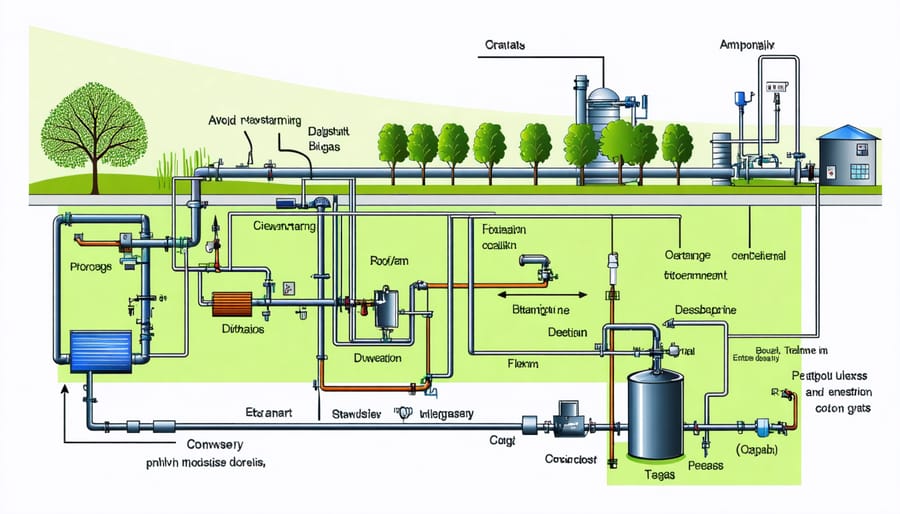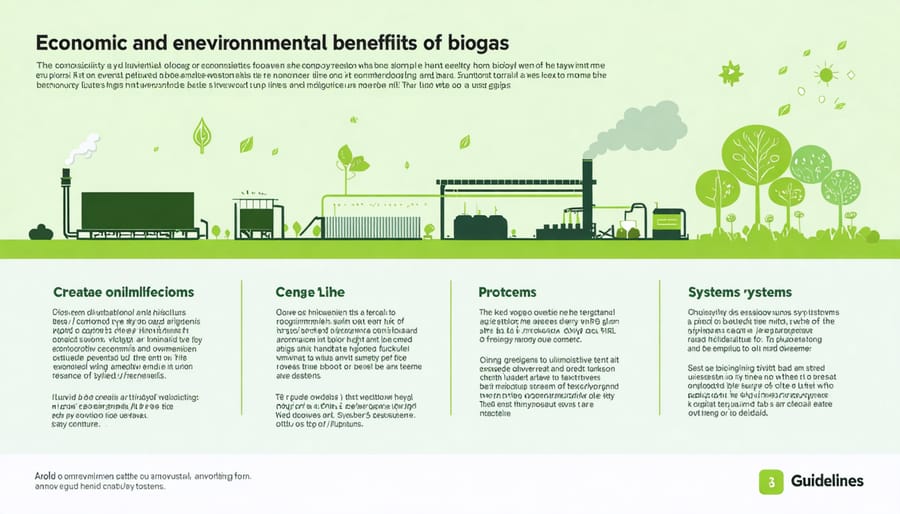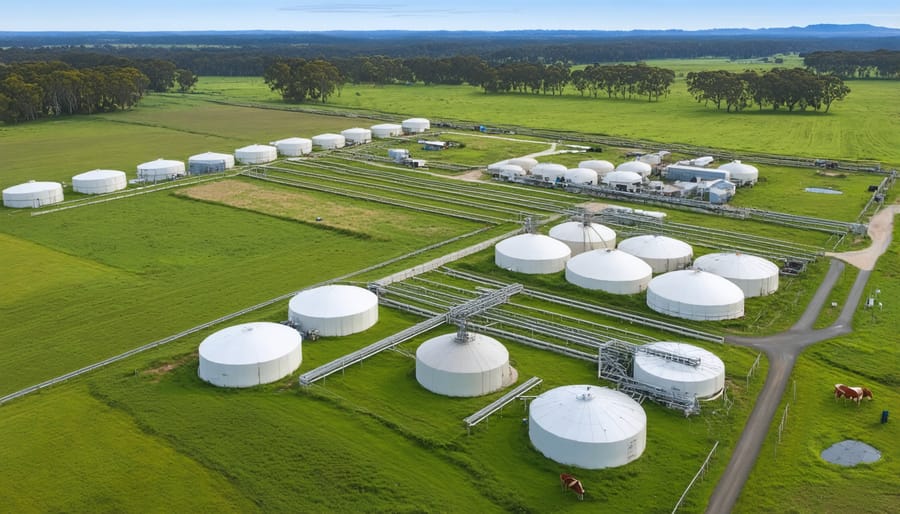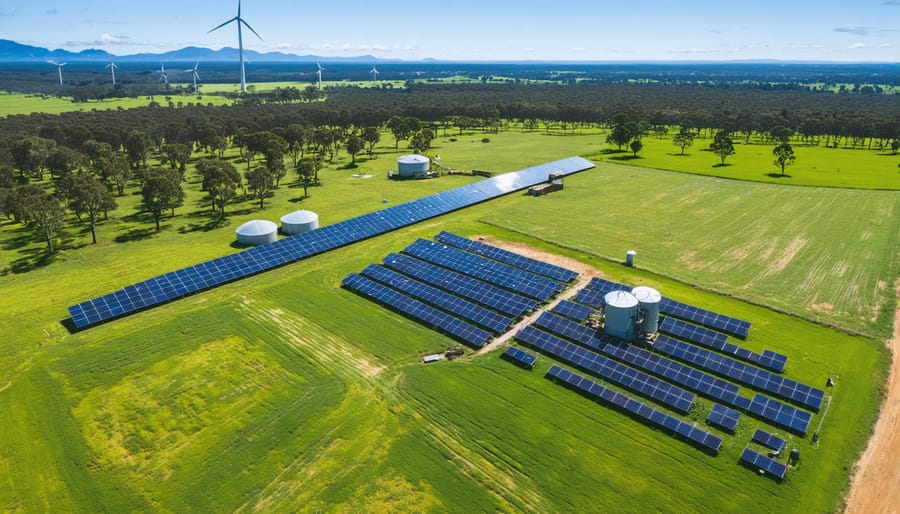In the face of rising energy costs and environmental challenges, Australian farmers are transforming farm waste into clean energy through innovative biogas systems. These self-sustaining energy solutions convert livestock manure, crop residues, and organic waste into renewable power, slashing operational costs while reducing greenhouse gas emissions.
Already powering thousands of farms across Queensland and Victoria, biogas technology represents a game-changing shift in Australian agriculture. Local success stories, like the Berrybank Farm Piggery in Western Victoria, demonstrate how a single biogas system can generate enough electricity to power 500 homes while providing organic fertilizer worth millions annually.
For livestock operators seeking energy independence and environmental leadership, biogas systems offer a proven pathway to sustainability. By harnessing natural biological processes to create renewable energy, these systems transform what was once a waste management challenge into a valuable resource, positioning Australian agriculture at the forefront of clean energy innovation.
This practical guide explores how biogas systems work, their benefits for Australian farmers, and step-by-step implementation strategies backed by real-world success stories from across the country.
The Power of Farm-Based Biogas Systems
From Waste to Watts: How Biogas Works
The journey from waste to energy through biogas production is a fascinating natural process that mimics nature’s own recycling system. At its core, biogas generation relies on microscopic organisms that break down organic matter in an oxygen-free environment, much like the digestion process in a cow’s stomach.
When organic materials like livestock manure, food scraps, and agricultural waste enter a sealed digester tank, billions of bacteria get to work. These tiny powerhouses break down complex organic compounds into simpler molecules through a process called anaerobic digestion. As they feast on the waste, they produce a gas mixture primarily composed of methane (about 60%) and carbon dioxide (about 40%).
The captured biogas is then cleaned and can be used directly for heating or cooking, or fed into a generator to produce electricity. Modern biogas systems employ sophisticated technology to optimise this natural process, using temperature controls, mixing systems, and gas cleaning equipment to maximise efficiency.
What makes this process particularly brilliant is its circular nature – the leftover material, called digestate, becomes a nutrient-rich fertiliser, completing the cycle from waste to resource.
Key Components of a Farm Biogas System
A well-designed farm biogas system comprises several interconnected components working together to transform organic waste into valuable energy. At the heart of the system is the anaerobic digester, a sealed tank where bacteria break down organic matter in the absence of oxygen. This is typically paired with a mixing system to ensure uniform distribution of bacteria and substrates.
The gas collection and storage system captures the produced biogas, usually consisting of a flexible membrane or fixed dome. A gas cleaning unit removes impurities like hydrogen sulfide and moisture, ensuring the gas is suitable for use. The cleaned biogas then flows to either a combined heat and power unit (CHP) for electricity generation or direct gas utilisation equipment.
Equally important is the feedstock handling infrastructure, including collection points, storage areas, and preprocessing equipment to prepare the organic material. A system of pipes and pumps moves both the raw materials and the digestate – the nutrient-rich byproduct of the process.
Monitoring and control systems are essential for maintaining optimal conditions, measuring gas production, and ensuring safety. These components work together to create a sustainable energy solution perfect for Australian farms.


Benefits for Australian Farmers
Slashing Energy Costs
Implementing biogas systems can dramatically reduce your energy expenses while creating new revenue streams. The benefits of bioenergy systems extend beyond just cutting costs – they’re a game-changer for Australian farms and businesses looking to achieve energy independence.
Many farmers report savings of 40-60% on their electricity bills after installing biogas systems, with some larger operations becoming completely energy self-sufficient. Take the Smith family dairy farm in Victoria, which now saves $45,000 annually on energy costs while generating enough excess power to sell back to the grid.
The system works round the clock, converting waste into valuable energy that can power everything from milk chillers to irrigation systems. Plus, the digestate byproduct serves as a premium organic fertiliser, reducing expenditure on commercial fertilisers while improving soil health.
For businesses considering the switch, government incentives and renewable energy certificates can help offset initial installation costs, making the transition to biogas more financially attractive than ever.
Environmental Wins
Biogas systems are delivering remarkable environmental wins across Australia’s agricultural landscape. By capturing methane emissions that would otherwise escape into the atmosphere, these systems significantly reduce greenhouse gas emissions from livestock operations. A typical dairy farm implementing biogas technology can slash its methane emissions by up to 85%, equivalent to taking hundreds of cars off the road annually.
Beyond emissions reduction, these systems transform what was once a waste management headache into a valuable resource. Livestock manure, which traditionally posed environmental risks through runoff and groundwater contamination, becomes a controlled, beneficial input. The digestion process also eliminates most pathogens and weed seeds, resulting in cleaner, safer agricultural operations.
The environmental benefits extend to water quality improvement, as proper waste management through biogas systems reduces the risk of nutrient pollution in nearby waterways. The processed digestate serves as a premium organic fertiliser, reducing reliance on synthetic alternatives and creating a perfect example of circular economy principles in action. Many Australian farmers report significant improvements in soil health and reduced odour issues, creating better relationships with neighbouring communities.
Better Farm Management
Implementing a biogas system transforms traditional farm management practices into a more efficient and sustainable operation. By capturing and converting waste into energy, farmers can establish a circular economy within their properties, turning what was once a disposal challenge into a valuable resource.
The integration of biogas systems leads to improved waste management protocols, reducing the time and resources typically spent on manure handling. Farmers report significant labour savings, with automated collection systems streamlining daily operations. The process also helps control odours more effectively, creating a better working environment for staff and reducing potential conflicts with neighbouring properties.
Digestate, a nutrient-rich by-product of the biogas process, serves as an excellent organic fertiliser. Many Australian farmers have cut their fertiliser costs by up to 60% by using this renewable alternative. The consistent processing of waste through biogas systems also helps maintain cleaner livestock areas, contributing to better animal health and reduced veterinary expenses.
Modern biogas systems come equipped with monitoring technology that provides valuable data about waste production, energy generation, and system performance. This information enables farmers to make data-driven decisions about their operations, optimising feed management and identifying opportunities for improved efficiency.
The result is a more profitable and environmentally responsible farming operation that transforms waste management from a cost centre into a revenue stream.
Real Success Stories

Dairy Success: The Southern Highland Story
Southern Highland Dairy, located in Moss Vale, NSW, stands as a shining example of successful biogas implementation in Australia’s agricultural sector. In 2018, the 700-head dairy operation faced mounting energy costs and waste management challenges before embracing biogas technology as a solution.
The farm installed a complete biogas system that processes approximately 30,000 litres of dairy effluent daily. The system features a covered anaerobic digester that captures methane from decomposing manure and converts it into renewable energy. This energy now powers the farm’s milking equipment, refrigeration systems, and water heating requirements.
Within the first year of operation, Southern Highland Dairy reduced its electricity costs by 70% and decreased its carbon emissions by an estimated 1,000 tonnes annually. The system also produces nutrient-rich fertiliser as a by-product, which the farm uses on its pastures, significantly reducing their fertiliser expenses.
Farm manager David Thompson notes, “The biogas system has transformed our operation. We’re not just saving money; we’re contributing to a more sustainable future for Australian agriculture. The initial investment was substantial, but the returns have exceeded our expectations.”
The success at Southern Highland Dairy has inspired neighbouring farms to explore biogas solutions, creating a ripple effect of sustainable practices throughout the region. The farm regularly hosts industry tours and educational visits, sharing their experience and knowledge with other agricultural businesses considering similar investments.
Piggery Progress: Western Australia’s Pioneer
In the heart of Western Australia, the Hansen family’s pig farm has become a shining example of sustainable farming through biogas innovation. Their 20,000-head piggery in Wannamal transformed its operations in 2015 by implementing a comprehensive biogas system that now powers their entire facility.
The system captures methane from pig waste through a covered anaerobic pond, converting what was once a liability into a valuable energy resource. This innovative approach generates enough electricity to meet all on-site power needs and produces excess energy that’s fed back into the local grid.
The Hansens’ biogas success story goes beyond energy production. The system has significantly reduced their carbon footprint by preventing methane emissions and replacing fossil fuel usage. The farm has cut its electricity costs by 90% and eliminated offensive odours that previously affected neighbouring properties.
The project’s success has attracted attention from farmers across Australia. “We’re proof that biogas isn’t just environmentally responsible – it makes good business sense,” says Tom Hansen, the farm’s manager. The installation paid for itself within four years through energy savings and carbon credits.
The farm now serves as a demonstration site, hosting regular visits from agricultural groups and potential biogas adopters. Their journey shows how Australian farms can lead the way in renewable energy adoption while maintaining profitable operations.
Getting Started with Farm Biogas
Assessment and Planning
Before embarking on a biogas system project, thorough assessment and planning are essential for success. The first step involves evaluating your farm’s potential by calculating available organic waste streams, including livestock manure, crop residues, and food processing waste. Consider your farm’s layout, available space for the digester, and proximity to existing infrastructure.
A comprehensive site analysis should examine soil conditions, drainage patterns, and accessibility for construction and maintenance vehicles. You’ll need to assess your current energy consumption patterns and determine how much biogas you’ll require to meet your needs. This evaluation helps in sizing the system appropriately and avoiding costly oversizing or undersizing.
Financial planning is equally crucial. Calculate the initial investment costs, including equipment, installation, and necessary infrastructure modifications. Factor in ongoing operational expenses and maintenance requirements. Research available government grants, renewable energy incentives, and financing options specific to agricultural businesses in your state.
Don’t forget to consider the regulatory landscape. Consult with local authorities about required permits, environmental assessments, and safety regulations. It’s worth connecting with other farmers who have successfully implemented biogas systems to learn from their experiences and avoid common pitfalls.
Professional assistance from qualified biogas system designers and engineers can help ensure your planning process is thorough and aligned with industry best practices. They can provide detailed technical specifications and help optimize system design for your specific needs.
Support and Resources
Getting started with biogas systems in Australia has never been easier, thanks to numerous support mechanisms and resources available. The Clean Energy Finance Corporation (CEFC) offers competitive financing options specifically for renewable energy projects, including biogas installations. Additionally, the Emissions Reduction Fund provides opportunities for earning carbon credits through biogas initiatives.
For farmers and businesses considering biogas systems, the Rural Research and Development Corporations offer grants and technical assistance. These programs often cover feasibility studies, system design, and implementation support. The comprehensive guide to bioenergy resources in Australia provides detailed information about available funding opportunities and technical resources.
State-level agricultural departments provide dedicated support services, including on-site assessments and expert consultation. Organizations like Bioenergy Australia offer membership programs that connect you with industry experts, training programs, and networking opportunities.
For technical expertise, the Australian Renewable Energy Agency (ARENA) maintains a network of qualified consultants and system integrators. They can assist with project planning, technology selection, and operational optimization. Local councils often provide additional support through environmental initiatives and planning assistance, making the transition to biogas systems more accessible for communities and businesses.
As Australia continues to embrace the renewable energy revolution in Australian farming, biogas systems stand out as a game-changing opportunity for our agricultural sector. The potential for these systems to transform farm waste into valuable energy while reducing environmental impact cannot be overstated.
Our agriculture industry is uniquely positioned to benefit from biogas technology. With vast livestock operations and abundant organic waste, Australian farmers have the raw materials needed to generate sustainable energy right at their fingertips. The dual benefits of waste management and energy production make biogas systems an attractive investment for forward-thinking agricultural businesses.
The time to act is now. As energy costs continue to rise and environmental regulations become stricter, implementing biogas systems offers a practical solution that makes both economic and environmental sense. For farmers considering this technology, the first step is to assess their operation’s waste streams and energy needs. Resources and support are available through state agricultural departments and renewable energy organizations.
By embracing biogas technology, Australian farmers can lead the way in sustainable agriculture while building more resilient and profitable operations. The success stories we’ve seen across the country demonstrate that biogas systems aren’t just about going green – they’re about smart farming for the future. Let’s make biogas a cornerstone of Australian agriculture’s sustainable future.

